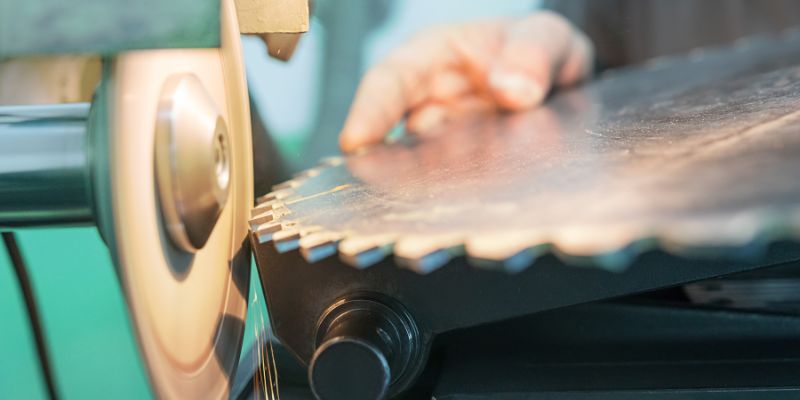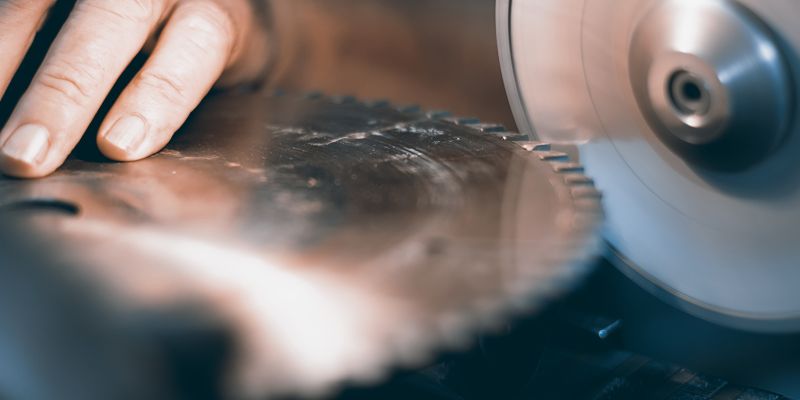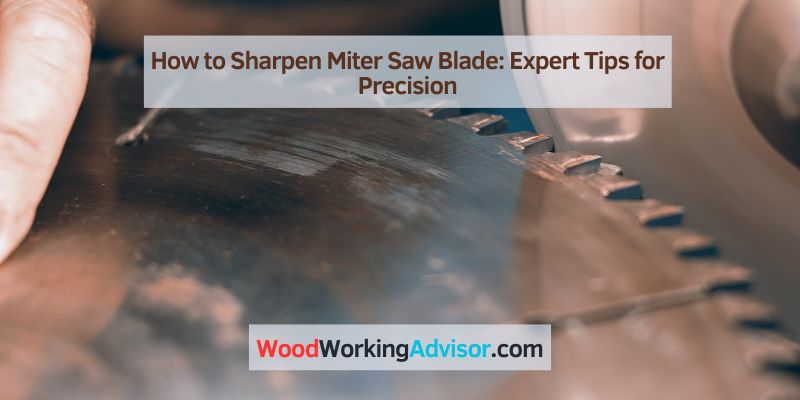To sharpen a miter saw blade, start by removing the blade from the saw and securing it in a vise. Then, use a diamond file or a specialized sharpening tool to carefully file each tooth of the blade.
It’s important to maintain a consistent angle and pressure while sharpening to ensure even sharpness across the entire blade. After filing, use a wire brush to remove any metal shavings and then reattach the blade to the miter saw. Regularly maintaining and sharpening the blade will ensure clean and precise cuts for your woodworking projects, saving you time and money in the long run.
Importance Of Sharp Miter Saw Blades
Having a sharp miter saw blade is crucial for achieving accurate and precise cuts in woodworking projects. Whether you are a professional carpenter or a hobbyist woodworker, the precision of your cuts significantly relies on the condition of your miter saw blade.
Significance Of Precision In Woodworking
Woodworking is an art that demands precision and accuracy in every cut. Whether you are creating a custom-made piece of furniture or crafting intricate designs, the quality of your work depends on the accuracy of the cuts you make. A sharp miter saw blade ensures that your cuts are clean, smooth, and perfectly angled, allowing you to create high-quality finished products.
Consequences Of Using Dull Blades
Using a dull miter saw blade can lead to a myriad of issues that can greatly affect the outcome of your woodworking projects. Dull blades tend to tear the wood fibers rather than cleanly cutting through them, resulting in rough and uneven edges. Additionally, these blades can cause friction and burning on the wood, leading to a less polished and professional appearance of the workpiece.
Furthermore, inaccurate cuts due to a dull blade can lead to misaligned joints and improper fits, compromising the structural integrity of your woodworking projects. This can ultimately result in rework, wasted materials, and a significant loss of time and resources.

Recognizing Dullness In Saw Blades
Recognizing dullness in saw blades is essential for maintaining the sharpness of your miter saw blade. Look for signs of wear and tear, such as burning marks or rough cuts, and then take necessary steps to sharpen the blade to ensure clean and precise cutting.
Regular maintenance is crucial for optimal performance.
Symptoms Of A Blade In Need Of Sharpening
It’s essential to recognize the signs of a dull saw blade to maintain optimal performance and ensure precision in your woodworking projects. One of the key symptoms of a blade in need of sharpening is the appearance of burn marks on the wood surfaces. Burn marks are a result of the blade’s inability to make clean, smooth cuts, indicating that the teeth are no longer sharp enough to slice through the material effectively.
Another evident symptom is the presence of tear-out along the edges of the cut. Tear-out occurs when the blade chips or splinters the wood instead of producing clean edges, affecting the overall quality of your workpiece. Furthermore, a dull blade tends to create excessive noise during operation, a clear indication that the cutting action is becoming less efficient.
Effects On Cut Quality And Safety
A dull miter saw blade not only compromises the quality of cuts but also poses a risk to safety. With decreased cutting efficiency, the blade requires more force to complete the cut, potentially leading to kickback and material jamming. This endangers both the operator and the integrity of the workpiece. Additionally, a dull blade can result in inaccurate angles and imprecise cuts, affecting the overall aesthetic and structural integrity of the project.
How To Sharpen Miter Saw Blade: Preparation
Safety Precautions And Equipment
Prior to sharpening a miter saw blade, it is essential to prioritize safety precautions and ensure the availability of the necessary equipment. Wearing safety goggles, gloves, and a dust mask is critical to protect yourself from any potential hazards during the sharpening process. Additionally, be sure to clear the work area of any obstructions and ensure that the miter saw is unplugged before beginning the process. As for the required equipment, a cleaning brush, lubricating oil, a diamond file or sharpening stone, and a vise or clamps are essential tools for effectively sharpening the miter saw blade.
Cleaning The Blade Before Sharpening
Prior to sharpening the miter saw blade, thorough cleaning is essential to ensure optimal sharpening results. Use a stiff bristle brush to remove any accumulated sawdust, resin, or debris from the blade. Apply a degreasing cleaner to effectively remove any accumulated oil or residues. This crucial step not only facilitates the sharpening process but also maximizes the blade’s lifespan and cutting performance.
Selecting The Right Sharpening Tools
Selecting the right sharpening tools for your miter saw blade is crucial to maintaining its cutting performance. Understanding the various options available and knowing when to use manual or professional sharpening methods can make a significant difference in the quality of your cuts and the longevity of the blade. Let’s dive into the key considerations when it comes to selecting the right sharpening tools for your miter saw blade.
Manual Vs. Professional Sharpening Methods
When it comes to sharpening your miter saw blade, you have the choice between manual sharpening methods and professional sharpening services. Manual sharpening involves using tools that can be operated by hand, while professional sharpening methods typically involve using specialized machinery or services provided by experienced professionals.
Types Of Sharpening Tools: Files, Diamond Whetstones, And Others
There are several types of sharpening tools to consider when maintaining your miter saw blade. Some popular options include:
- Files: Hand files are commonly used for manual sharpening, offering precision and control when reshaping and sharpening miter saw blades.
- Diamond Whetstones: Diamond whetstones provide a durable and effective sharpening surface that can be used for both coarse and fine sharpening, making them versatile tools for maintaining miter saw blades.
- Others: Additional sharpening tools such as rotary tool attachments and sharpening jigs offer alternative methods to keep your miter saw blade in optimal cutting condition.
Each of these sharpening tools has its unique advantages, and the choice often depends on personal preference, the condition of the blade, and the desired level of sharpness. Understanding the characteristics of each tool can help you make an informed decision when selecting the right sharpening tools for your miter saw blade.

Sharpening Techniques For Precision
Learn precise sharpening techniques for miter saw blades to achieve accurate cuts. Implementing the proper methods and tools can enhance the blade’s precision, resulting in cleaner and more efficient cuts for your woodworking projects. Regular maintenance and sharpening will ensure optimal performance and longevity of your miter saw blade.
Step-by-step Process Of Blade Sharpening
Maintaining a miter saw blade’s sharpness is crucial for achieving precise and accurate cuts. To ensure precision, it’s essential to understand the step-by-step process of blade sharpening and expert tips for maintaining blade balance.
Step-by-step Process Of Blade Sharpening
Sharpening a miter saw blade requires attention to detail and precision. Follow these steps for a successful blade sharpening process:
- Remove the blade from the miter saw and place it on a clean, flat surface.
- Inspect the teeth for any damage or dullness. If there are any chips or dull spots, use a file to gently remove them.
- Secure the blade in a vise to keep it steady during sharpening.
- Use a diamond file or sharpening stone to carefully sharpen each tooth. Maintain a consistent angle and pressure to ensure uniform sharpening.
- After sharpening, clean the blade thoroughly to remove any metal shavings or debris.
- Reinstall the sharp blade back onto the miter saw and perform a test cut to ensure the sharpness and precision.
Expert Tips For Maintaining Blade Balance
Maintaining blade balance is crucial for achieving precise and accurate cuts. Consider these expert tips to ensure your miter saw blade remains balanced:
- Regularly clean the blade to remove resin and debris that may affect its balance.
- Use a blade-balancing tool to check for any imbalances and make necessary adjustments.
- Inspect the arbor and blade flanges for any damage or irregularities that may affect the balance of the blade.
- Ensure the saw’s spindle and arbor nut are properly tightened to prevent vibration and maintain balance during cutting.
- Rotate the blade periodically to promote even wear and maintain its balance over time.
Fine-tuning For Optimal Performance
When it comes to achieving precise and clean cuts with your miter saw, fine-tuning the blade for optimal performance is crucial. Maintaining a sharp and properly tensioned blade is essential for ensuring accuracy and safety when using your miter saw. In this guide, we will cover the key steps for fine-tuning your miter saw blade to achieve optimal performance.
Testing Blade Sharpness
Before making any adjustments, it’s important to determine the sharpness of the miter saw blade. Use a simple test to check the sharpness by running your finger lightly across the edge of the blade. If the blade feels dull or rough, it’s time to sharpen it. A sharp blade is essential for achieving clean and accurate cuts. If the blade is dull, it may lead to jagged edges and splintered cuts, affecting the overall quality of your work. Take the necessary steps to sharpen the blade before proceeding with any other adjustments.
Adjusting Blade Tension For Accuracy
Blade tension plays a crucial role in the performance of a miter saw. Proper tension ensures smooth and accurate cuts, while inadequate tension can lead to blade drift and imprecise cuts. Begin by carefully adjusting the tension of the blade according to the manufacturer’s recommendations. Consult the miter saw manual for specific instructions on how to adjust the blade tension. If you’re unsure, seek assistance from a professional or an experienced woodworker to avoid potential damage to the saw. A well-tensioned blade will ensure precision and safety during operation.
Maintaining The Sharpness Over Time
After sharpening your miter saw blade, it’s important to maintain its sharpness over time by following best practices for storage and implementing routine maintenance.
Best Practices For Blade Storage
- Store the miter saw blade in a cool, dry place to prevent rust and corrosion.
- Use protective covers or blade sleeves to prevent damage and maintain sharpness.
- Ensure that the storage area is free from humidity and direct sunlight to prevent deterioration.
Routine Maintenance To Extend Blade Life
- Regularly clean the blade after each use using a blade cleaning solution and a soft brush to remove resin, pitch, and other debris.
- Inspect the blade for any signs of damage or wear, and replace it if necessary to maintain optimal performance.
- Implement a regular sharpening schedule based on usage to ensure the blade remains sharp and efficient.
Frequently Asked Questions For How To Sharpen Miter Saw Blade
How Often Should I Sharpen My Miter Saw Blade?
It’s best to sharpen your miter saw blade after around 40 hours of use. Regularly checking for dullness and sharpening as needed will ensure clean, precise cuts.
What Are The Signs That My Miter Saw Blade Needs Sharpening?
Look for burning wood, splintering, or chipping in your cuts. These are telltale signs that your blade is dull and needs sharpening to maintain its performance.
Can I Sharpen My Miter Saw Blade Myself?
Yes, you can sharpen your miter saw blade at home using a diamond blade sharpener or a sharpening file. However, it’s crucial to follow the manufacturer’s guidelines and safety precautions.
Conclusion
Knowing how to sharpen a miter saw blade is crucial for maintaining precise and efficient cuts. By following the steps outlined in this guide, you can ensure that your miter saw blade remains in top condition, prolonging its lifespan and enhancing the quality of your woodworking projects.
Happy cutting!


